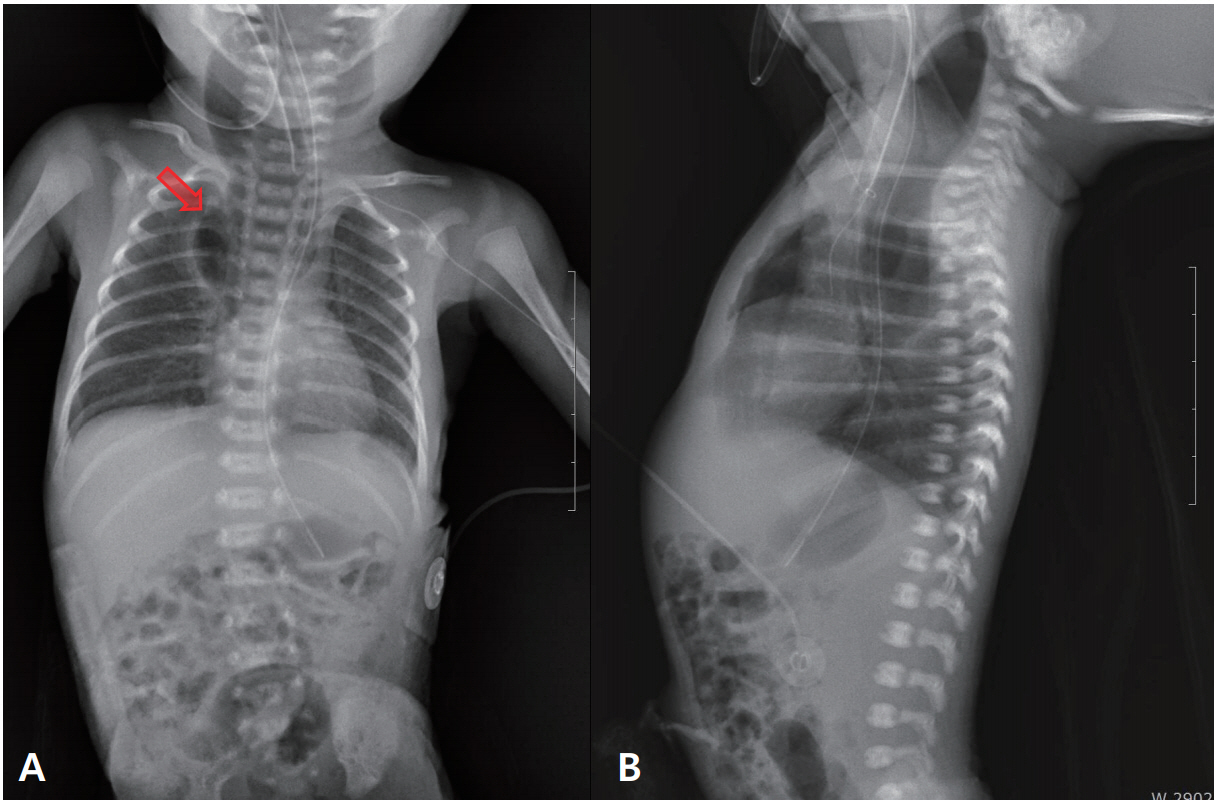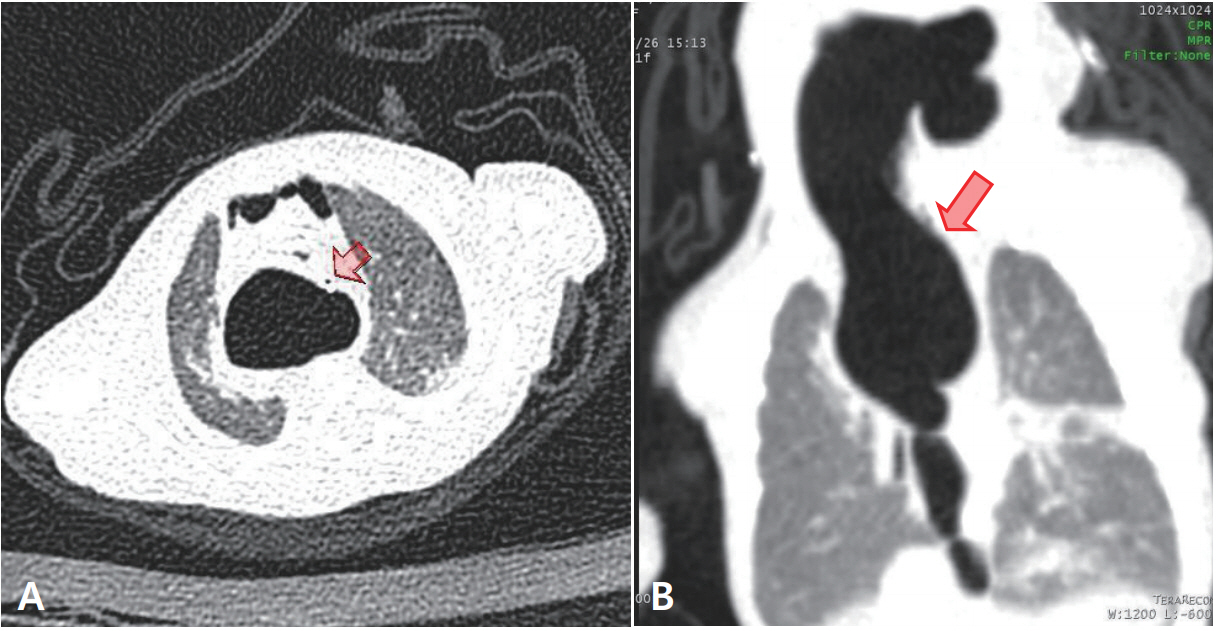Neonatal Med.
2020 Feb;27(1):21-25. 10.5385/nm.2020.27.1.21.
A Case of Neonatal Pneumomediastinum with Subcutaneous Emphysema Suspected to Be Caused by Pharyngoesophageal Injury
- Affiliations
-
- 1Department of Pediatrics, Jeonbuk National University Medical School, Jeonju, Korea
- 2Research Institute of Clinical Medicine of Jeonbuk National University-Biomedical Research Institute of Jeonbuk National University Hospital, Jeonbuk National University Medical School, Jeonju, Korea
- KMID: 2502089
- DOI: http://doi.org/10.5385/nm.2020.27.1.21
Abstract
- Iatrogenic esophageal perforation is a rare condition in children, but occasionally occurs in premature infants due to repeated intubation or nasogastric tube insertion. Esophageal perforation is common in pneumothorax and interstitial emphysema, but rarely occurs in the absence of pneumothorax. Although complications, such as mediastinitis, after esophageal perforation are rare, they can be fatal. Therefore, rapid and accurate diagnosis and appropriate treatment are important. The authors report a case of huge retrocardiac pneumomediastinum and subcutaneous emphysema suspected to be caused by esophageal perforation after repeated intubation.
Figure
Reference
-
1. Emil SG. Neonatal esophageal perforation. J Pediatr Surg. 2004; 39:1296–8.2. Sapin E, Gumpert L, Bonnard A, Carricaburu E, Sava E, Contencin P, et al. Iatrogenic pharyngoesophageal perforation in premature infants. Eur J Pediatr Surg. 2000; 10:83–7.3. Hesketh AJ, Behr CA, Soffer SZ, Hong AR, Glick RD. Neonatal esophageal perforation: nonoperative management. J Surg Res. 2015; 198:1–6.4. Gander JW, Berdon WE, Cowles RA. Iatrogenic esophageal perforation in children. Pediatr Surg Int. 2009; 25:395–401.5. Stapp J, Stewart DL, Eberly S. Atypical latrogenic perforation of the distal esophagus in an ELBW neonate. Clin Pediatr (Phila). 2001; 40:637–8.6. Garey CL, Laituri CA, Kaye AJ, Ostlie DJ, Snyder CL, Holcomb GW 3rd, et al. Esophageal perforation in children: a review of one institution's experience. J Surg Res. 2010; 164:13–7.7. Rentea RM, St Peter SD. Neonatal and pediatric esophageal perforation. Semin Pediatr Surg. 2017; 26:87–94.8. Al-Khawahur HA, Al-Salem AH. Iatrogenic perforation of the esophagus. Saudi Med J. 2002; 23:732–4.9. Filippi L, Pezzati M, Poggi C. Use of polyvinyl feeding tubes and iatrogenic pharyngo-oesophageal perforation in very-low-birthweight infants. Acta Paediatr. 2005; 94:1825–8.10. Soong WJ. Endoscopic diagnosis and management of iatrogenic cervical esophageal perforation in extremely premature infants. J Chin Med Assoc. 2007; 70:171–5.11. Seefelder C, Elango S, Rosbe KW, Jennings RW. Oesophageal perforation presenting as oesophageal atresia in a premature neonate following difficult intubation. Paediatr Anaesth. 2001; 11:112–8.12. Pumberger W, Bader T, Golej J, Pokieser P, Semsroth M. Traumatic pharyngo-oesophageal perforation in the newborn: a condition mimicking oesophageal atresia. Paediatr Anaesth. 2000; 10:201–5.13. Panieri E, Millar AJ, Rode H, Brown RA, Cywes S. Iatrogenic esophageal perforation in children: patterns of injury, presentation, management, and outcome. J Pediatr Surg. 1996; 31:890–5.14. Warden HD, Mucha SJ. Esophageal perforation due to trauma in the newborn. A case report. Arch Surg. 1961; 83:813–5.15. Jones WG 2nd, Ginsberg RJ. Esophageal perforation: a continuing challenge. Ann Thorac Surg. 1992; 53:534–43.16. Blair GK, Filler RM, Theodorescu D. Neonatal pharyngoesophageal perforation mimicking esophageal atresia: clues to diagnosis. J Pediatr Surg. 1987; 22:770–4.17. Macklin MT, Macklin CC. Malignant interstitial emphysema of the lungs and mediastinum as an important occult complication in many respiratory diseases and other conditions: an interpretation of the clinical literature in the light of laboratory experiment. Medicine. 1944; 23:281–358.18. Rosenfeld DL, Cordell CE, Jadeja N. Retrocardiac pneumomediastinum: radiographic finding and clinical implications. Pediatrics. 1990; 85:92–7.19. Agut A, Talavera J, Buendia A, Anson A, Santarelli G, Gomez S. Imaging diagnosis-spontaneous pneumomediastinum secondary to primary pulmonary pathology in a dalmatian dog. Vet Radiol Ultrasound. 2015; 56:E54–7.20. Amodio JB, Berdon WE, Abramson SJ, Oh KS, Oudjhane K, Wung JT. Retrocardiac pneumomediastinum in association with tracheal and esophageal perforations. Pediatr Radiol. 1986; 16:380–3.
- Full Text Links
- Actions
-
Cited
- CITED
-
- Close
- Share
- Similar articles
-
- Pneumoperitoneum from Subcutaneous Emphysema after Blunt Chest Injury
- Pneumomediastinum and Subcutaneous Emphysema after Use of a High-Speed Dental Handpiece
- A Case of Pneumorrhachis Associated with Spontaneous Pneumomediastinum and Subcutaneous Emphysema
- A Case of Nonspecific Interstitial Pneumonia Complicated with Spontaneous Pneumomediastinum, Subcutaneous Emphysema and Pneumatosis Interstinalis
- A Case of Subcutaneous Emphysema and Pneumomediastinum after Palatine Tonsillectomy




